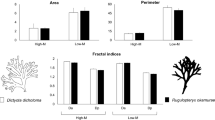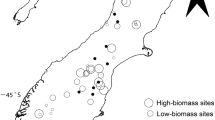Abstract
The biotic resistance hypothesis predicts that more diverse communities should have greater resistance to invasions than species-poor communities. However for facultative and obligate epiphytic invaders a high native species richness, abundance and community complexity might provide more resources for the invader to thrive to. We conducted surveys across space and time to test for the influence of native algal species abundance and richness on the abundance of the invasive facultative epiphytic filamentous alga Lophocladia lallemandii in a Mediterranean Cystoseira balearica seaweed forest. By removing different functional groups of algae, we also tested whether these relationships were dependent on the complexity and abundance of the native algal community. When invasion was first detected, Lophocladia abundance was positively related to species richness, but the correlation became negative after two years of invasion. Similarly, a negative relationship was also observed across sites. The removal experiment revealed that more complex native communities were more heavily invaded, where also a positive relationship was found between native algal richness and Lophocladia, independently of the native algal abundance. Our observational and experimental data show that, at early stages of invasion, species-rich seaweed forests are not more resistant to invasion than species-poor communities. Higher richness of native algal species may increase resource availability (i.e. substrate) for invader establishment, thus facilitating invasion. After the initial invasion stage, native species richness decreases with time since invasion, suggesting negative impacts of invasive species on native biodiversity.




Similar content being viewed by others
References
Arenas F, Sánchez I, Hawkins S, Jenkins S (2006) The invasibility of marine algal assemblages: role of functional diversity and identity. Ecology 87:2851–2861
Ballesteros E (1992) Els vegetals i la zonació litoral: espècies, comunitats i factors que influeixen en la seva distribució. Arx Secc Ciències IEC 101:1–656
Ballesteros E, Cebrian E, Alcoverro T (2007) Mortality of shoots of Posidonia oceanica following meadow invasion by the red alga Lophocladia lallemandii. Bot Mar 50:8–13
Ballesteros E, Garrabou J, Hereu B, Zabala M, Cebrian E, Sala E (2009) Deep water stands of Cystoseira zosteroides C. Agardh (Fucales, Ochrophyta) in the Northwestern Mediterranean: insights into assemblage structure and population dynamics. Estuar Coast Shelf Sci 82:477–484
Bonaviri C, Vega Fernández T, Fanelli G, Badalamenti F, Gianguzza P (2011) Leading role of the sea urchin Arbacia lixula in maintaining the barren state in southwestern Mediterranean. Mar Biol 158:2505–2513
Brooks WR, Jordan RC (2013) Propagule pressure and native species richness effects drive invasibility in tropical dry forest seedling layers. Perspect Plant Ecol Evol Syst 15:162–170
Bulleri F, Benedetti-Cecchi L (2008) Facilitation of the introduced green alga, Caulerpa racemosa, by resident algal turfs: experimental evaluation of underlying mechanisms. Mar Ecol Prog Ser 364:77–86
Bulleri F, Bruno JF, Benedetti-Cecchi L (2008) Beyond Competition: incorporating positive interactions between species to predict ecosystem invasibility. PLoS Biol 6(6):e162
Bulleri F, Benedetti-Cecchi L, Jaklin A, Ivesa L (2016) Linking disturbance and resistance to invasion via changes in biodiversity: a conceptual model and an experimental test on rocky reefs. Ecol Evol 6:2010–2021
Callaway RM, Reinhart KO, Moore GW, Moore DJ, Pennings SC (2002) Epiphyte host preferences and host traits: mechanisms for species-specific interactions. Oecologia 132:221–230
Capers RS, Selsky R, Bugbee GJ, White JC (2007) Aquatic plant community invasibility and scale-dependent patterns in native and invasive species richness. Ecology 88:3135–3143
Catford JA, Vesk PA, Ricardson DM, Pysek P (2012) Quantifying levels of biological invasion: towards the objective classification of invaded and invasible ecosystems. Glob Change Biol 18:44–62
Cebrian E, Ballesteros E (2009) Temporal and spatial variability in shallow- and deep-water population of the invasive Caulerpa racemosa var. cylindracea in the Western Mediterranean. Estuar Coast Shelf Sci 83:469–474
Cebrian E, Ballesteros E (2010) Invasion of Mediterranean benthic assemblages by red alga Lophocladia lallemandii (Montagne) F. Schmitz: depth-related temporal variability in biomass and phenology. Aquat Bot 92:81–85
Cebrian E, Ballesteros E, Canals M (2000) Shallow rocky bottom benthic assemblages as calcium carbonate producers in the Alboran Sea (Southwestern Mediterranean). Oceanol Acta 23:311–322
Ceccherelli G, Piazzi L, Balata D (2002) Spread of introduced Caulerpa species in macroalgal habitats. J Exp Mar Bio Ecol 280:1–11
Clark GF, Johnston EL (2011) Temporal change in the diversity–invasibility relationship in the presence of a disturbance regime. Ecol Lett 14:52–57
Clark GF, Johnston EL, Leung B (2013) Intrinsic time dependence in the diversity–invasibility relationship. Ecology 94:25–31
Davis MA, Grime JP, Thompson K (2000) Fluctuating resources in plant communities: a general theory of invasibility. J Ecol 88:528–534
Elton CS (1958) The ecology of invasions by animals and plants. Methuen, London
Fargione J, Tilman D (2005) Diversity decreases invasion via both sampling and complementarity effects. Ecol Lett 8:604–611
Fargione J, Brown CS, Tilman D (2003) Community assembly and invasion: an experimental test of neutral versus niche processes. Proc Nat Acad Sci 100:8916–8920
Fine PVA (2002) The invasibility of tropical forests by exotic plants. J Trop Ecol 18:687–705
Flores-Palacios A, García-Franco JG (2006) The relationship between tree size and epiphyte species richness: testing four different hypotheses. J Biogeogr 33:323–330
Fridley JD (2011) Invasibility of communities and ecosystems. In: Simberloff D, Rejmanek M (eds) Encyclopedia of biological invasions. University of California, Berkeley and Los Angeles, pp 356–359
Fridley JD, Stachowicz JJ, Naeem S, Sax DF, Seabloom EW, Smith MD, Stohlgren TJ, Tilman D, Von Holle B (2007) The invasion paradox: reconciling pattern and process in species invasions. Ecology 88:3–17
Giacconne G, Bruni A (1973) Le Cistoseire e la vegetazione sommersa del Mediterraneo. Atti Ist Ven Sci Lett Arti 131:59–103
Hierro JL, Maron JL, Callaway RM (2005) A biogeographical approach to plant invasions: the importance of studying exotics in their introduced and native range. J Ecol 93:5–15
Howard TG, Gurevitch J, Hyatt L, Carreiro M, Lerdau M (2005) Forest invasibility in communities in southeastern New York. Biol Invasion 6:393–410
Kennedy TA, Naeem S, Howe KM, Knops JMH (2002) Biodiversity as a barrier to ecological invasion. Nature 147:636–638
Knowlton N (2004) Multiple “stable” states and the conservation of marine ecosystems. Prog Oceanogr 60:387–396
Ladwig LM, Meiners SJ (2009) Impacts of temperate lianas on tree growth in young deciduous forests. For Ecol Manag 259:195–200
Levine JM, D’Antonio C (1999) Elton revisited: a review of evidence linking diversity and invasibility. Oikos 87:15–26
Lewis JEJ, Ellis CJ (2010) Taxon-compared with trait-based analysis of epiphytes, and the role of tree species and tree age in community composition. Plant Ecol Divers 3:203–210
Lonsdale WM (1999) Global patterns of plant invasions and the concept of invasibility. Ecology 80:1522–1536
Loreau M (1998) Biodiversity and ecosystem function: a mechanistic model. Proc Nat Acad Sci 95:5632–5636
Marbà N, Arthur R, Alcoverro T (2014) Getting turfed: the population and habitat impacts of Lophocladia lallemandii invasions on endemic Posidonia oceanica meadows. Aquat Bot 116:76–82
Maron J, Marler M (2008) Field-based competitive impacts between invaders and natives at varying resource supply. J Ecol 96:1187–1197
Marraffini ML, Geller JB (2015) Species richness and interacting factors control invasibility of a marine community. Proc R Soc B 282:20150439
McGranahan DA, Engle DM, Wilsey BJ, Fuhlendorf SD, Miller JR, Debinski DM (2012) Grazing and an invasive grass confound spatial pattern of exotic and native grassland plant species richness. Basic Appl Ecol 13:654–662
Naeem S, Knops JMH, Tilman D, Howe KM, Kennedy T, Gale S (2000) Plant diversity increases resistance to invasion in the absence of covarying extrinsic factors. Oikos 91:97–108
Östman Ö, Eklöf J, Eriksson BK, Olsson J, Moksnes PO, Bergstrom U (2016) Top-down control as important as nutrient enrichment for eutrophication effects in North Atlantic coastal ecosystems. J Appl Ecol 53:1138–1147
Otero M, Cebrian E, Francour P, Galil B, Savini D (2013) Monitoring marine invasive species in Mediterranean Marine Protected Areas (MPAs): a strategy and practical guide for managers. IUCN, Malaga, p 136
R Development Core Team (2011) R: a language and environment for statistical computing. R Foundation for Statistical Computing, Vienna
Rejmánek M (1996) Species richness and resistance to invasions. In: Orians G, Dirzo R, Cushman H (eds) Biodiversity and ecosystem processes in tropical forests. Springer, Berlin, pp 153–172
Robinson GR, Quinn JF, Stanton ML (1995) Invasibility of experimental habitat islands in a California winter annual grassland. Ecology 76:786–794
Scherer-Lorenzen M, Schulze ED, Don A, Schumacher J, Weller E (2007) Exploring the functional significance of forest diversity: a new long-term experiment with temperate tree species (BIOTREE). Perspect Plant Ecol Evol Syst 9:53–70
Shea K, Chesson P (2002) Community ecology theory as a framework for biological invasions. Trends Ecol Evol 17:170–176
Simberloff D (2009) The role of propagule pressure. Ann Rev Ecol Evol Syst 40:81–102
Stachowicz JJ, Byrnes JE (2006) Species diversity, invasion success, and ecosystem functioning: disentangling the influence of resource competition, facilitation, and extrinsic factors. Mar Ecol Prog Ser 311:251–262
Stachowicz JJ, Whitlatch RB, Osman RW (1999) Species diversity and invasion resistance in a marine ecosystem. Science 286:1577–1579
Stohlgren TJ, Barnett DT, Kartesz JT (2003) The rich get richer: patterns of plant invasions in the United States. Front Ecol Environ 1:11–14
Theoharides KA, Dukes JS (2007) Plant invasion across space and time: factors affecting nonindigenous species success during four stages of invasion. New Phytol 176:256–273
Valdivia N, Heidemann A, Thiel M, Molis M, Wahl M (2005) Effects of disturbance on the diversity of hard-bottom macrobenthic communities on the coast of Chile. Mar Ecol Prog Ser 299:45–54
Van Ruijven J, De Deyn GB, Berendse F (2003) Diversity reduces invasibility in experimental plant communities: the role of plant species. Ecol Lett 6:910–918
Verlaque M, Ruitton S, Mineur F, Boudouresque CF (2015) CIESM Atlas of exotic species in the Mediterranean. In: Briand F (ed) Macrophytes, vol 4. CIESM, Monaco, p 364
Vilà M, Pino J, Font X (2007) Regional assessment of plant invasions across different habitat types. J Veget Sci 18:35–42
Acknowledgements
This project has received funding from the Spanish Ministry Projects (CGL2016-76341-R and CGL2015-65346-R) and Fundación Biodiversidad. This output reflects only the authors’ views and the European Union cannot be held responsible for any use that may be made of the information contained therein. Managers of ACNP are acknowledged for sampling permissions. This is a contribution to CoCoNET (FP7 Grant Agreement: 287844) and INTRAMURAL CSIC 201330E065. EBD receives financial support from the Spanish Ministerio de Economía y Competitividad, through the Severo Ochoa Program for Centres of Excellence in R + D + I (SEV-2012-0262). EC is a member of the Marine Conservation Research Group (www.medrecover.org) from the Generalitat de Catalunya.
Author information
Authors and Affiliations
Corresponding author
Electronic supplementary material
Below is the link to the electronic supplementary material.
Rights and permissions
About this article
Cite this article
Cebrian, E., Tomas, F., López-Sendino, P. et al. Biodiversity influences invasion success of a facultative epiphytic seaweed in a marine forest. Biol Invasions 20, 2839–2848 (2018). https://doi.org/10.1007/s10530-018-1736-x
Received:
Accepted:
Published:
Issue Date:
DOI: https://doi.org/10.1007/s10530-018-1736-x




